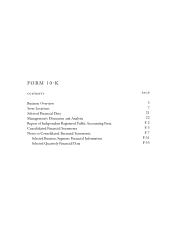TJ Maxx 2009 Annual Report Download - page 25
Download and view the complete annual report
Please find page 25 of the 2009 TJ Maxx annual report below. You can navigate through the pages in the report by either clicking on the pages listed below, or by using the keyword search tool below to find specific information within the annual report.
with or furnished to the SEC. They are also available free of charge from TJX Investor Relations, 770 Cochituate Road,
Framingham, Massachusetts, 01701. The public can read and copy materials at the SEC’s Public Reference Room at
100 F Street, NE, Washington, DC 20549, 1-800-SEC-0330. The SEC maintains a website containing all reports,
proxies, information statements, and all other information regarding issuers that file electronically (http://www.sec.gov).
Information appearing on TJX’s website is not a part of, and is not incorporated by reference in, this Form 10-K.
Unless otherwise indicated, all store information in this Item 1 is as of January 30, 2010, and references to store
square footage are to gross square feet. Fiscal 2008 means the fiscal year ended January 26, 2008, fiscal 2009 means the
fiscal year ended January 31, 2009, fiscal 2010 means the fiscal year ended January 30, 2010 and fiscal 2011 means the
fiscal year ending January 29, 2011.
Unless otherwise stated or the context otherwise requires, references in this Form 10-K to “TJX,” “we,” “us” and
“our” refer to The TJX Companies, Inc. and its subsidiaries.
ITEM 1A. RISK FACTORS
The statements in this section describe the major risks to our business and should be considered carefully, in
connection with all of the other information set forth in this annual report on Form 10-K. The risks that follow,
individually or in the aggregate, are those that we think could cause our actual results to differ materially from those
stated or implied in forward-looking statements.
Global economic conditions may adversely affect our financial performance.
In 2009, economies worldwide were in crisis, and global financial markets experienced extreme volatility, disruption
and credit contraction. The volatility and disruption to the capital markets significantly adversely affected global
economic conditions, resulting in additional significant recessionary pressures and declines in employment levels,
disposable income and actual and perceived wealth. Although there has been some recent improvement, continuing or
worsened adverse economic conditions, including higher unemployment, energy and health care costs, interest rates and
taxes and tighter credit, could continue to affect consumer confidence and discretionary consumer spending adversely
and may adversely affect our sales, cash flows and results of operations. Additionally, renewed financial turmoil in the
financial and credit markets could adversely affect our costs of capital and the sources of liquidity available to us and
could increase our pension funding requirements.
Fluctuations in foreign currency exchange rates may lead to lower revenues and earnings.
In addition to our U.S. businesses, we operate stores in Canada and Europe and plan to continue to expand our
international operations. Sales made by our stores outside the United States are denominated in the currency of the
country in which the store is located, and changes in foreign exchange rates affect the translation of the sales and earnings
of these businesses into U.S. dollars for financial reporting purposes. Because of this, movements in exchange rates have
had and are expected to continue to have a significant impact on our net sales and earnings.
Additionally, we routinely enter into inventory-related hedging instruments to mitigate the impact of foreign
exchange on merchandise margins of merchandise purchased by our international segments that is denominated in
currencies other than their local currencies. In accordance with U.S. GAAP, we evaluate the fair value of these hedging
instruments and make mark-to-market adjustments at the end of an accounting period. These adjustments are of a much
greater magnitude when there is significant volatility in currency exchange rates and may have a significant impact on our
earnings.
In addition, changes in foreign exchange rates can increase the cost of inventory purchases by our businesses that are
denominated in a currency other than the local currency of the business. When these changes occur suddenly, it can be
difficult for us to adjust retail prices accordingly, and gross margin can be adversely affected.
Although we implement foreign currency hedging and risk management strategies to reduce our exposure to
fluctuations in earnings and cash flows associated with changes in foreign exchange rates, we expect that foreign currency
fluctuations could have a material adverse effect on our net sales and results of operations.
9
























